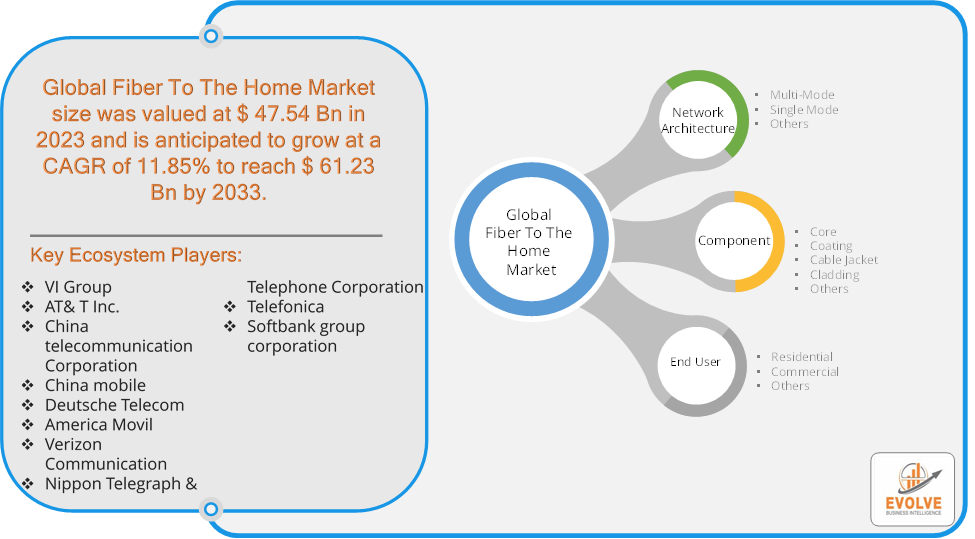Blog
Fiber to the Home Market Expected to Grow at 11.85% CAGR During Forecast Period

Evolve Business Intelligence has published a research report on the Global Fiber To The Home Market, 2023–2033. The global Fiber To The Home Market is projected to exhibit a CAGR of around 11.85% during the forecast period of 2023 to 2033.
Evolve Business Intelligence has recognized the following companies as the key players in the global Fiber To The Home Market: VI Group, AT& T Inc., China telecommunication Corporation, China mobile, Deutsche Telecom, America Movil, Verizon Communication, Nippon Telegraph & Telephone Corporation, Telefonica and Softbank group corporation.
 More Information: https://evolvebi.com/report/fiber-to-the-home-market-analysis/
More Information: https://evolvebi.com/report/fiber-to-the-home-market-analysis/
Market Highlights
The Global Fiber To The Home Market is projected to be valued at USD 61.23 Billion by 2033, recording a CAGR of around 11.85% during the forecast period. The Fiber to the Home (FTTH) Market refers to the market segment focused on providing high-speed internet and telecommunications services directly to residential buildings via fiber optic cables. FTTH is part of the broader category of fiber to the premises (FTTP), which includes fiber connections to homes, businesses, and other buildings.
The FTTH market is characterized by rapid technological advancements, increasing consumer demand for high-speed connectivity, and significant investment in infrastructure development. While deployment costs pose a challenge, the long-term benefits in terms of speed, reliability, and capacity make it a promising market segment.
The COVID-19 pandemic had a significant impact on the Fiber to the Home (FTTH) market. With lockdowns and social distancing measures in place, many people shifted to remote work and online education. This led to a surge in demand for reliable, high-speed internet connections, driving growth in the FTTH market. The pandemic accelerated the adoption of telehealth services, requiring robust internet connections that FTTH networks are well-suited to provide. The pandemic caused disruptions in global supply chains, affecting the availability of fiber optic cables and other necessary equipment. This led to delays in network deployment and expansion. Social distancing measures and lockdowns made it challenging for technicians to perform installations and maintenance, slowing down the rollout of FTTH services in some areas. The pandemic highlighted the importance of robust internet infrastructure, likely leading to sustained growth in the FTTH market as remote work and digital services continue to play a significant role post-pandemic.
Segmental Analysis
The global Fiber To The Home Market has been segmented based on Network Architecture, Component and End User.
Based on Network Architecture, the Fiber To The Home Market is segmented into Multi-Mode, Single Mode and Others. The Multi-Mode segment is anticipated to dominate the market.
Based on Component, the global Fiber To The Home Market has been divided into the Core, Coating, Cable Jacket, Cladding and Others. The Cable Jacket segment is anticipated to dominate the market.
Based on End User, the global Fiber To The Home Market has been divided into the Residential, Commercial and Others. The Commercial segment is anticipated to dominate the market.
More Information: https://evolvebi.com/report/fiber-to-the-home-market-analysis/
Regional Analysis
The Fiber To The Home Market is divided into five regions: North America, Europe, Asia-Pacific, South America, and the Middle East, & Africa. The FTTH market in North America is well-developed, driven by high demand for high-speed internet and strong investment from service providers. The region benefits from a competitive landscape, with major telecom companies expanding their fiber networks. Increasing remote work, online education, and the adoption of smart home technologies are key growth drivers in this region. In Europe region, Countries like Germany, France, and the UK are experiencing significant FTTH growth, fueled by government initiatives and consumer demand for high-speed internet. The European Union’s Digital Agenda aims to provide high-speed broadband access to all citizens, boosting FTTH deployment. The FTTH market is expanding rapidly in Eastern Europe, driven by investment in infrastructure and efforts to improve internet access in rural areas. The Asia-Pacific region is a global leader in FTTH deployment, with China and Japan at the forefront. Extensive government support and large-scale infrastructure projects have enabled rapid growth. These countries have some of the highest FTTH penetration rates globally. Strong government backing, technological advancements, and increasing digitalization drive the FTTH market in Asia-Pacific. The region’s large population and growing middle class also contribute to demand for high-speed internet services. The FTTH market in Latin America is expanding, with Brazil and Mexico leading the charge. Investments in infrastructure and government initiatives to improve broadband access are driving growth in this region. The rise of online education, remote work, and digital entertainment are key drivers of FTTH adoption in Latin America. Government programs aimed at bridging the digital divide also support market growth. The FTTH market in the Middle East is growing, with countries like the UAE and Saudi Arabia investing in advanced telecommunications infrastructure to support smart city initiatives and digital transformation. FTTH deployment is limited in many parts of Africa due to economic constraints and infrastructure challenges. However, there is potential for growth as governments and private companies invest in broadband expansion.



